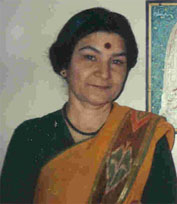Darshan Ranganathan facts for kids
Quick facts for kids
Darshan Ranganathan
|
|
|---|---|
 |
|
| Born | 4 June 1941 |
| Died | 4 June 2001 (aged 60) |
| Nationality | Indian |
| Alma mater | Delhi University |
| Known for | ATP-imidazole cycle, urea cycle, designing protein tertiary structure |
| Spouse(s) | Subramania Ranganathan |
| Awards | Fellow of the Indian Academy of Sciences; TWAS Prize in Chemistry, 1999; Senior Research Scholarship of the Royal Commission for the Exhibition of 1851, A.V. Rama Rao Foundation Award, Jawaharlal Nehru Birth Centenary Visiting Fellowship, and Sukh Dev Endowment Lectureship. |
| Scientific career | |
| Fields | Organic chemistry |
| Institutions | IIT Kanpur |
| Thesis | (1967) |
| Doctoral advisor | T.R. Sheshadri |
Darshan Ranganathan (born June 4, 1941 – died June 4, 2001) was a brilliant organic chemist from India. She was famous for her amazing work in bio-organic chemistry. This field combines biology and chemistry.
She made big discoveries in how proteins fold into their correct shapes. She also worked on creating tiny structures and copying important biological processes in the lab.
Contents
Early Life and Education
Darshan Markan was born in Delhi, India, on June 4, 1941. Her parents were Vidyavati Markan and Shanti Swarup. She studied chemistry at Delhi University. In 1967, she earned her Ph.D. in chemistry.
She started her career as a lecturer. Later, she became the head of the Chemistry Department at Miranda College in Delhi. She then received a special scholarship. This allowed her to do advanced research in London.
Her Scientific Journey
In 1970, Darshan Ranganathan started her research at the Indian Institute of Technology, Kanpur (IIT Kanpur). That same year, she married Subramania Ranganathan. They worked together on many science books. These books included Challenging problems in organic reaction mechanisms.
Even though she was a top scientist, she faced some challenges. Rules at IIT Kanpur meant she could not join the faculty. This was because her husband was already a professor there. So, she continued her research through special fellowships.
Later, she moved to other research labs in India. She worked at the Regional Research Laboratory in Trivandrum from 1993. Then, in 1998, she joined the IICT in Hyderabad. There, she became a Deputy Director. She also worked closely with scientist Isabella Karle in the United States.
Darshan Ranganathan passed away on her 60th birthday in 2001. She had been battling breast cancer.
Recognized for Her Work
Darshan Ranganathan was a highly respected scientist. She was a Fellow of the National Academy of Sciences. She also won many important awards for her contributions to chemistry.
- She received the A.V. Rama Rao Foundation Award.
- She won the Jawaharlal Nehru Birth Centenary Visiting Fellowship.
- In 1999, she earned the Third World Academy of Sciences Award in Chemistry. This was for her outstanding work in bio-organic chemistry.
- She also received the Sukh Dev Endowment Lectureship.
At the time of her death, she was one of India's most published organic chemists. Her work appeared in many top scientific journals. Her husband created the "Professor Darshan Ranganathan Memorial Lecture" in her honor. This lecture is given by a leading woman scientist every two years.
What She Studied
Darshan Ranganathan loved to recreate natural processes in the lab. She wanted to understand how living things work at a chemical level.
- She found a way to make imidazole in the lab. Imidazole is a key part of important biological molecules.
- She also created a working model of the urea cycle. This is a vital process that helps our bodies get rid of waste.
- As her career grew, she became an expert in designing proteins. She could make proteins take on many different shapes.
- She also designed tiny structures called nanostructures. She did this using self-assembling peptides. These are small protein pieces that can put themselves together.
See also
 In Spanish: Darshan Ranganathan para niños
In Spanish: Darshan Ranganathan para niños

